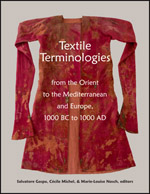Center, Textile Research

Textile Terminologies from the Orient to the Mediterranean and Europe, 1000 BC to 1000 AD
Date of this Version
2017
Document Type
Article
Citation
In Textile Terminologies from the Orient to the Mediterranean and Europe, 1000 BC to 1000 AD, ed. Salvatore Gaspa, Cécile Michel, & Marie-Louise Nosch (Lincoln, NE: Zea Books, 2017), pp. 346-373.
doi:10.13014/K2SN074F
Abstract
During the 1st millennium AD, silk became the most desirable fibre in the Mediterranean region. While the expansion of silk production and consumption is widely acknowledged, specific features of the industry’s development are more difficult to discern. Chroniclers had little reason to document silk manufacturing processes, and producers were not inclined to record or publicise their trade secrets. Historical knowledge of silk comes mainly from accounts of its consumption in a variety of forms and contexts.
For the middle Byzantine period (AD 843-1204), the two most elaborated sources associated with silk date from the 10th century. The Book of the Eparch (BOE) (911/12) is a collection of regulations applied to guilds under the supervision of the eparch of Constantinople. The Book of Ceremonies (BOC), attributed to Emperor Constantine VII Porphyrogennetos (945-959), is a compilation of 5th- to 10th-century protocols used by court officials to stage imperial rituals. Together, these sources have shaped much of the existing Byzantine scholarship pertaining to silk. The conventional interpretation is that for much of the middle Byzantine period, silk was an imperial prerogative confined to the most elite members of society. However, close reading of the larger body of source evidence shows that the prevailing Byzantine silk narrative has numerous shortcomings and limited value in the study of historic processes. From the standpoint of contemporary scholarship, the role of silk in the middle Byzantine period requires reconsideration through application of current research methods.
To provide a more secure historical basis for silk research, other types of writing should be considered including histories, chronicles, and testamentary documents. A survey of Byzantine and other contemporary sources dated between the 6th and 13th centuries reveals a large number of textual ‘mentions’ describing textiles. Many mentions contain only partial information, but include terms associated with silk such as production place, materials, weave type, end use, design, quality, and usage context. Philologists have long tried to clarify the meaning of textile words in Byzantine sources with limited success. For example, in his preface to BOC, Vogt observed that it is not possible to know the precise nuances of textile-related terms. The general view is that lexical analysis can recognise the incidence of various words, but there is seldom sufficient descriptive information in written works to form a reconstructive view of textiles. Probing more deeply, there are several reasons why textile terminology presents such a challenge. With few exceptions, authors used specific textile terms in context without elaborated definition or provision of descriptive details. Like other specialised lexicons, textile terminology usage was sometimes inconsistent and localised. Moreover, textile terms were not stable, but evolved different meanings over time. Various factors contributed to the migration of meaning including changes in material type, production location, and technology. In recent decades, new research methods supported by computer information technologies have equipped historians to analyse evidence more exhaustively and dynamically than in the past. To study Byzantine textile terminology, I developed a relational database of textile mentions similar in concept and form to a prosopography. This database comprises over 800 descriptive mentions of textiles found in a variety of Byzantine sources dating from the 6th to 13th centuries. The resulting corpus provides an evidentiary basis to discern patterns that are difficult to perceive with conventional methods. The textile mention database supports critical examination of textual evidence to define the meaning of terms pertaining to or associated with silk in the middle Byzantine period. This process is aided by considering written sources from a framework that follows the general sequence of silk textile processes including material acquisition and preparation, textile construction, decoration, and pattern reproduction. The larger objective is to use the collective terminology data to redefine historical understanding of silk in the middle Byzantine period by demonstrating its social importance, contribution to technology development, and integration in the regional economy.
Included in
Ancient History, Greek and Roman through Late Antiquity Commons, Art and Materials Conservation Commons, Classical Archaeology and Art History Commons, Classical Literature and Philology Commons, Fiber, Textile, and Weaving Arts Commons, Indo-European Linguistics and Philology Commons, Jewish Studies Commons, Museum Studies Commons, Near Eastern Languages and Societies Commons, Other History of Art, Architecture, and Archaeology Commons


Comments
Copyright © 2017 Salvatore Gaspa, Cécile Michel, & Marie-Louise Nosch. Photographs copyright as noted.